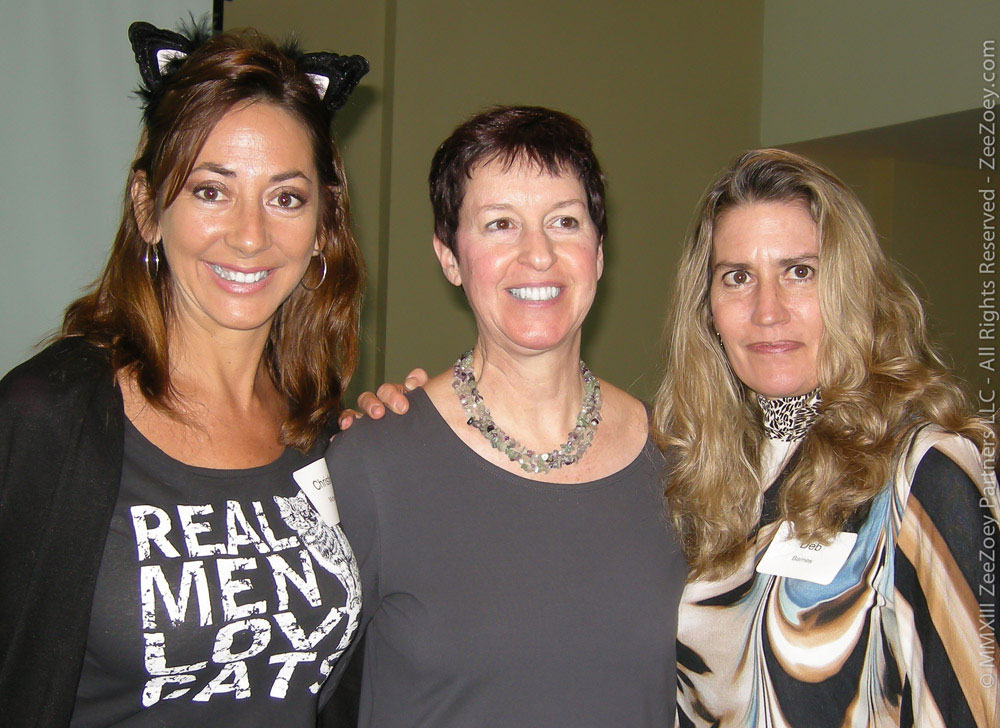Zee & Zoey’s Spay/Neuter Series – Making Sense of Cat Overpopulation When the Numbers Don’t Add Up

In order to help make a significant dent in cat overpopulation, a basic course in cat math and procreation is needed.
Case in point – in math, one plus one equals two and the subject is closed for debate. When it comes to one fertile female cat who mates with one un-neutered male cat and they have kittens, however, the collective number of offspring they could be responsible for in a seven year time frame ranges anywhere from 5000 to 420,000 kittens. Quite a discrepancy to say the least. And while it might appear on the surface the more profound number of 420,000 kittens allows a better chance of bringing attention to a serious subject, I have to respectfully disagree.
Do a quick Google search asking the question, “How many kittens could a female cat have in her lifetime?” The number one site that pops up is wiki.anwers.com and it confirms the 420,000 figure. Why is this so bad? Number one – because people tend to trust what they read, and number two, because these kinds of erroneous numbers lead people to believe cat overpopulation is too overwhelming to control and that spay/neuter efforts don’t work.
It also inspires justification of tragic euthanizations, overstated reports on cats killing birds, stereotypes about cat-crazy ladies with homes overrun with cats, and general cat-hating mayhem. Public policy for reform and change cannot possibly occur in a national mainstream effort if we don’t arm ourselves with facts on the actual numbers of kittens that can realistically be born and proven solutions that whatever the numbers are, they can be managed and controlled through spay/neuter efforts.

It would seem if one unaltered pair of male/female cats could be responsible for producing up to 420,000 kittens in seven years that we would not be able to open our doors without stepping on a sea of cats…
The conclusion – while theoretically a female cat can have over three litters a year, those are extreme and highly unlikely conditions. A cat’s heat cycle is based on climate and daylight hours, so more realistically would be a cat having one to two litters a year. Of those litters, especially for outdoor feral cats, only about 75% of the kittens live to reach reproductive age. It is now more widely accepted that an unspayed female cat could have between 98 – 200 kittens in her lifetime. When you factor in possible offspring from offspring during that 7 year time frame, the more realistic number would be a collective 5000. Still a high number, but nowhere near the 420,000 figure.
The 420,000 figure is an urban myth that began sometime around 2005 with the Humane Society of the United States. They have long since removed the number from their site and it remains a mystery how the staggering number originated to begin with, which is part of the overall dilemma we face as cat advocates – many of the facts that are available to us are spotty and generalized at best. For example, the ASPCA reports that there are upward of 70 million homeless cats in the United States and approximately 5 to 7 million cats and dogs enter shelters every year, with 70% of the cats euthanized because the number of these cats far exceeds the number of adopters.
But where are the figures year by year, state by state, county by county, and city by city? I have seen that 70 million figure for years. Wouldn’t it fluctuate from year to year? And why do they lump cats with dogs as one category of animals that enter shelters? How many are cats and how many are dogs? Because there is not a national central database with statistics for every shelter across the country as to how many cats are euthanized each year and how many actual cats live outdoors or how numbers on how populations are reduced through TNR (Trap, Neuter, Return), we cannot accurately access where our efforts need to be best concentrated.

Christine Michaels of Riverfront Cats, Becky Robinson, Founder of Alley Cat Allies, and myself at a “Changing Community Cats” seminar held by Alley Cat Allies as part of a nationwide tour they are conducting with community cat advocates to help educate, change, and reform local pound and shelter systems by promoting the virtues of TNR programs.
We know that there are success stories where TNR works, such as the New York City Feral Cat Initiative, Spartanburg Animal Services of South Carolina, and Jacksonsville Florida Feral Freedom to name a few and we need to use these examples as a powerful tools that make headlines rather than the overly sensationalized stories about cat hoarders or well intended PSA’s on local channels that only a handful of people watch. Or worse yet, depressing commercials with sad music and pictures of cats in cages – these images do not inspire pet responsibly and they do not discuss how and why spay/neuter not only controls overpopulation, but that it makes for a happier and healthier pet.
The dots have to be connected for people to understand – by promoting spay/neuter, cats are healthier and better behaved. As a result of that, far less of them will be brought to shelters for undesirable traits such as aggressive fighting and urine spraying that spay/neuter corrects. Less of them will be dumped on the streets with the potential to mate and contribute to the population of outdoor cat colonies – and those cats that do live on the streets can be managed and controlled through TNR efforts. The message that adopting a cat into your family can improve the quality of a person’s life needs to be heard loud and clear. A cat can decrease our depression, stress and anxiety levels. They can also lower our blood pressure and decrease the risk of heart attack and stroke and they make loving and devoted companions.
Let’s face it, we need the message of responsible spay/neuter to go viral like Keyboard Cat. We need our school systems to teach the virtues of spay/neuter as part of the curriculum so that our youth grows up with the importance of the message. We need NBC Nightly News, 60 Minutes, Nightline, Ellen DeGeneres, The View, The Talk and more to devote significant air time to the fact that cat overpopulation can be reduced and managed if we commit ourselves as communities to the effort. And regardless of any of the numbers or statistics, in my opinion, every cat or kitten deserves a good home, and even one cat that has to suffer is one cat too many…
For further information on spay/neuter, cat overpopulation, and more cat facts, please reference these detailed articles:
Zee & Zoey’s Spay/Neuter Series – The Facts of Life: The 101’s of Kittens and Conception
Zee & Zoey’s Spay/Neuter Series – Cat Overpopulation and the Moral Ethics of Time
























Fabulous!!! Thrilled to have you as a guest blogger tomorrow! To me…this paragraph says it all “The dots have to be connected for people to understand – by promoting spay/neuter, cats are healthier and better behaved. As a result of that, far less of them will be brought to shelters for undesirable traits such as aggressive fighting and urine spraying that spay/neuter corrects. Less of them will be dumped on the streets with the potential to mate and contribute to the population of outdoor cat colonies – and those cats that do live on the streets can be managed and controlled through TNR efforts. The message that adopting a cat into your family can improve the quality of a person’s life needs to be heard loud and clear. A cat can decrease our depression, stress and anxiety levels. They can also lower our blood pressure and decrease the risk of heart attack and stroke and they make loving and devoted companions.”
Thank you Caren – that paragraph really is the crux of the issue… just how can we get the message out there so that people “get it” in a quick and easy way! I’m looking forward to being featured on Cat Chat tomorrow and really appreciate the opportunity to share my story about what World Spay Day means to me to your readers!
We appreciate your efforts and those of all who spread the word about spay/neuter and TNR programs. It makes our mom cry whenever she hears about kitties being euthanized or just dumped on the street to fend for themselves. Keep up the good work. Purrs and hugs, Lily Olivia, Mauricio, Misty May Giulietta, Fiona, Astrid, Lisbeth and Calista Josette
Janet… it does make you want to cry, but that is why it is so important for us to stay strong and deliver a powerful message so that we can try to end the tragedies…
Mario’s mom here – yes, your headline sure caught my attention as my complexion is getting worse by the minute (PD is solely responsible for it tho). So I wanted to read more to see how this would be possible, even tho I knew what you were leading up to. Your wonderful article did exactly what you wanted it to do – makes one sit up and take notice. Bless you and all the others who are involved in this wonderful program.
Thank you mario – I really appreciate your kind words and am glad the headline did what I hoped it would do!!
Deb,
Great article, I’ve seen charts showing the number of kittens one pair produce, the it goes on to track kitten grown up, what they produce etc. It was in the millions!
Thank for the update on what Tuesdays blog will be. I won’t
be able to read it, I hope you understand.
Connie
Connie – I do understand and am so sorry for any pain you are going through. I hope that one day due to the efforts of myself and other adovocates, caretakers, volunteers, staff members, and organizations that are trying to make a difference, that we won’t have to discuss subjects like this ever again…
Wonderful information Deb. I truly appreciate you and your passion!!
You are welcome, Toni and thank you for sharing this post!
Well said my friend !
Thank you Layla!
another grate post Z & Z’s mom……N if we may brake away frum de thought bee hind de post N say
de mor trout ya eat, de younger ya look N feel….
try it…..flounder N mackeral werk just az well, perch….knot sew much !!
lookin for werd ta yur inter viewz two morrow !!
Hmmm…. trout, flounder, and mackeral… thank you for the advice, da tabbies of trout towne!! 🙂
Deb, one would wonder why these “experts” don’t ask those who are out there actively managing feral populations instead of regurgitating old estimates. And why do I count bird populations in my back yard and enter that data into an international database for purposes of real scientific use, but there is no place for me to enter my data on cats in my back yard? I don’t think I need to venture a guess.
The only figures we really know are the ones that actually happen. Mimi had 24 kittens in two years. To my knowledge, none reproduced, certainly not the kittens they gave to me to find good homes. End of story. But here’s a response to the nay-sayers to turn that 420,000 figure right back on them: “I prevented 420,000 kittens from being born–I spayed a cat!”
Bernadette – A round of applause for you!! I LOVED your response to the naysayers and say “kudos to you” for preventing so many kittens from being born!!! As far as asking those that manage feral populations, I know Alley Cat Allies is working hard to try to gather accurate information, but I do feel we are still a long way from that happening. The sad part also, many feral caretakers are under the radar for fear of having their cats trapped and taken by animal control, so many of them are reluctant to speak up. Uphill battle…
Great post and such an important subject. I for one sure hope you do get the message out there but it needs to be ;put out in the rural areas where people just don’t care about spaying and neutering.
You are correct, Marg. So many factors affect how we reach people and geography is one of them.
Fantastic post!
And that headline needs to go into some hall of fame list somewhere.
Thank you Fisher!! Let me know if you find that Hall of Fame and I’ll submit the headline!!
Great post today. Spaying/neutering is so important. And Marg is right…the message needs to get to those who don’t care and/or don’t know any better.
Yes… that’s the overall crux of the matter, Island Cats and the hardest part of the battle!
These days if you say something loud enough and long enough, it becomes the truth, unfortunately. So truth is now determined by the majority vote! Whatever the fact of the matter is, responsible people will spay/neuter their pets (unless specifically they are breeding). Sadly, emotive statements such as “a female giving birth to 420,000 kittens in her lifetime” can lead stupid people to make stupid decisions about dealing with cats! Excellent post, Deb x
Very well stated, CATachresis…. and so true! Why the right headlines can’t be as compelling is beyond me…
Hi Deb!
Great posting as always. You look so young in that photo!
Cats keep me young too. People are amazed at our ages, aren’t they? Interesting, feral cats have taught me even more to be grateful for what I have, and not sweat the small stuff. They endure so much and take life easy to survive. That’s why I am thrilled to spend an hour feeding, petting and checking on them as a volunteer instead of idle chat at happy hour. Those cats make me happy. Less stress does lower blood pressure, anxiety, lessen depression and thus wrinkles. A furrtain of Youth!
Thank you Black Cat Lady – next to you, anyone looks good!!! You and your beautiful Riverfront Cats have taught me so much and you are such an inspiration to the message I am trying to spread and teach!
Great post on the importance of spaying and neutering pets!
Thank you Beth – I appreciate you stopping by to comment!
Great Post! I am a firm believer in Trap, Neuter, Release and in neutering and spaying pets. All pets should have a good home.
Thank you Penelope – I sure hope one day that all pets have a good home too!
New reader/poster here. I came over from LinkedIn.
Great article! As long as the MSM continues to spout these falsehoods, we are going to be fighting an uphill battle. People are lazy and want soundbite solutions. Following the MSM is easy. Digging deeper to learn the FACTS is not.
The way I try to educate people is through leading by example. I try to be the best cat caretaker I can (to my pet cats–I don’t oversee a colony at this time), and I make myself open and available to talk with people, answer their questions, etc.
Jen – I truly appreciate you stopping by from LinkedIn. I am trying to reach a larger audience and really felt this post was essential to sharing. I find that for me, speaking from mistakes made from my own personal misconceptions, that is my greatest tool to educating people. I am not just spouting facts and figures – my lessons come from the heart and people relate to that!